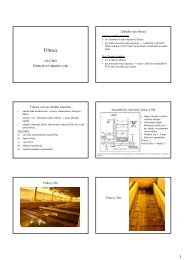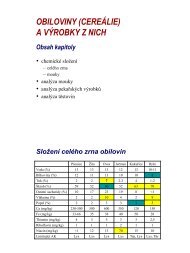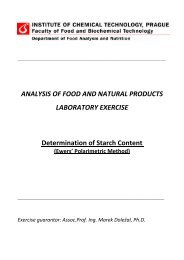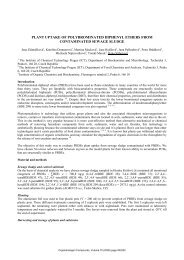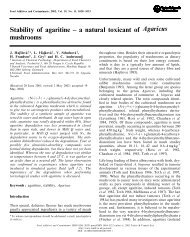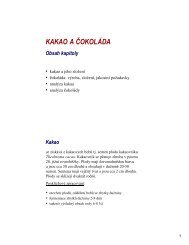The three-dimensional structure of humic substances and soil ...
The three-dimensional structure of humic substances and soil ...
The three-dimensional structure of humic substances and soil ...
Create successful ePaper yourself
Turn your PDF publications into a flip-book with our unique Google optimized e-Paper software.
64<br />
Table 2. Aromatic compounds characteristic for <strong>soil</strong> organic matter (see Table 1) [1]<br />
CH=CH 2<br />
H3C0 OCH 3<br />
(78) v\CH3 0H<br />
1118) 1134)<br />
(154)<br />
O%C--H ~J_C~N CH3<br />
H 3 OH<br />
(94) ~ CN2-CH3 (CH2)4-CH3<br />
(104)<br />
CH3 Y "0CH3<br />
H3 OH CH=CH-CHa<br />
OCH 3<br />
1120) 0CH 3<br />
(106) CH 3<br />
CH3_C=CH 2<br />
H 3 CH2-CH3 (CH3)2 OCH 3<br />
1106) OH 1164)<br />
(144) OC--CH 3<br />
0CH3 1146) OCH3<br />
(106) OH OH<br />
~OH ~CH3 (124) ~--~CH2)3-CH 3 ~(164)<br />
1108) (130) 1148) 1166)<br />
CH3 CH 3 - CH=CH2 ~3<br />
OH OH<br />
(116) y "OCH 3<br />
(134) OH<br />
ed as a first draft 2D <strong>structure</strong> [3]. It had the elemental<br />
composition <strong>of</strong> C308H328090N 5 with a molecular mass <strong>of</strong><br />
5 540.027 g tool -1 <strong>and</strong> an elemental analysis <strong>of</strong> 66.8% C,<br />
6.0% H, 26.0°70 O, 1.3% N. Compared to isolated stan-<br />
dard HAs with about 56.3070 C <strong>and</strong> 32.8% O, this pro-<br />
posed HA <strong>structure</strong> is obviously too high in carbon <strong>and</strong><br />
too low in oxygen. However, carbohydrates have been re-<br />
ported to account for about 10% <strong>of</strong> the HA weight <strong>and</strong><br />
a similar value has been suggested for proteinaceous ma-<br />
terials in HA [3]. Thus, it has been assumed that one HA<br />
molecule traps within its voids approximately 10% carbo-<br />
hydrates <strong>and</strong> 10% proteinaceous materials. <strong>The</strong> resulting<br />
HA complex has then an elemental composition <strong>of</strong><br />
C342H3880124N12 with a molecular mass <strong>of</strong> 6650.912g<br />
mo1-1 <strong>and</strong> an elemental analysis <strong>of</strong> 61.8% C, 5.9% H,<br />
_CH3 (CHe)s-CH3<br />
(152) 1176)<br />
29.8% O, 2.5% N. If more carbohydrates <strong>and</strong>/or pro-<br />
teinaceous materials are added, the C content decreases<br />
<strong>and</strong> the O content increases.<br />
Thus, for a stereochemical underst<strong>and</strong>ing <strong>of</strong> the<br />
<strong>structure</strong> <strong>of</strong> <strong>humic</strong> <strong>substances</strong> <strong>and</strong> their reactions with<br />
biological <strong>and</strong> anthropogenic compounds <strong>three</strong> main,<br />
urgent questions emerged:<br />
1. What is a fast, reliable <strong>and</strong> versatile method to convert<br />
the 2D <strong>structure</strong> into a 3D <strong>structure</strong>?<br />
2. Is it possible to optimize the geometry <strong>of</strong> the chemical<br />
3 D <strong>structure</strong> <strong>and</strong> to determine <strong>and</strong> minimize its en-<br />
ergy?<br />
3. How can chemical reactions <strong>of</strong> such complex biomac-



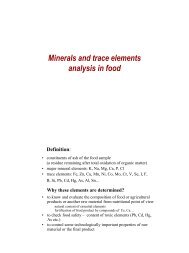
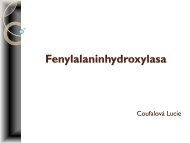

![Legislativa - Označování potravin [režim kompatibility]](https://img.yumpu.com/15533670/1/190x135/legislativa-oznacovani-potravin-rezim-kompatibility.jpg?quality=85)
